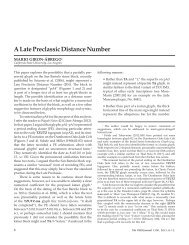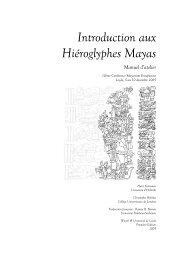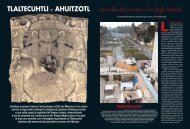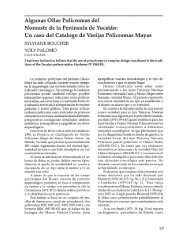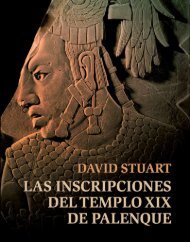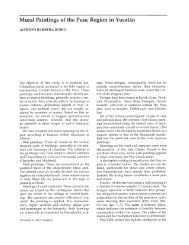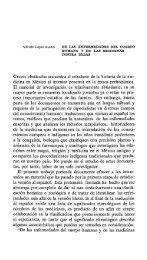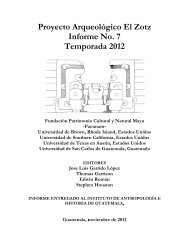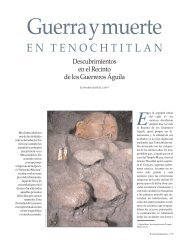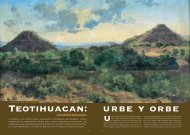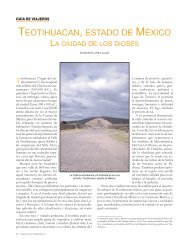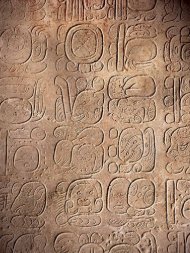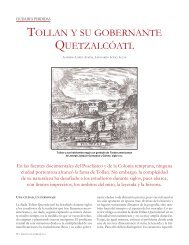Popol Vuh: Sacred Book of the Quiché Maya - Mesoweb
Popol Vuh: Sacred Book of the Quiché Maya - Mesoweb
Popol Vuh: Sacred Book of the Quiché Maya - Mesoweb
Create successful ePaper yourself
Turn your PDF publications into a flip-book with our unique Google optimized e-Paper software.
Guatemala City. An Austrian traveler named Carl Scherzer saw it <strong>the</strong>re in 1854 and had a<br />
copy made to take with him back to Europe. In part, Scherzer commissioned this copy to be<br />
made due to <strong>the</strong> poor condition <strong>of</strong> <strong>the</strong> manuscript. He described it as having been “written in<br />
such light ink that <strong>the</strong> original might very well become illegible and useless in a few years”<br />
(Scherzer 1856, 9). Lamentably, this faded copy <strong>of</strong> <strong>the</strong> Ximénez transcription <strong>of</strong> <strong>the</strong> <strong>Popol</strong><br />
<strong>Vuh</strong> has since vanished from public records. Scherzer published Ximénez’s Spanish version<br />
<strong>of</strong> <strong>the</strong> text in 1856, <strong>the</strong> first time <strong>the</strong> <strong>Popol</strong> <strong>Vuh</strong> had appeared in print. The book was greeted<br />
with a great deal <strong>of</strong> excitement in Europe and America, where interest in ancient cultures was<br />
widespread.<br />
In 1861, four years after Scherzer’s book, <strong>the</strong> <strong>Quiché</strong> version <strong>of</strong> <strong>the</strong> <strong>Popol</strong> <strong>Vuh</strong> was<br />
published for <strong>the</strong> first time, along with a ra<strong>the</strong>r flowery French translation by Fa<strong>the</strong>r Charles<br />
Etienne Brasseur de Bourbourg. This publication was based on yet ano<strong>the</strong>r copy <strong>of</strong> <strong>the</strong><br />
Ximénez transcription which Brasseur had obtained from a <strong>Quiché</strong> man, named Ignacio<br />
Coloch, who resided in <strong>the</strong> town <strong>of</strong> Rabinal. This manuscript is <strong>of</strong> supreme importance<br />
because it is <strong>the</strong> oldest known <strong>Quiché</strong> version <strong>of</strong> <strong>the</strong> <strong>Popol</strong> <strong>Vuh</strong> text which has survived.<br />
Ximénez was in charge <strong>of</strong> <strong>the</strong> parish <strong>of</strong> Rabinal from 1704-1714, immediately following his<br />
years in Chichicastenango. It is unknown whe<strong>the</strong>r Ximénez prepared <strong>the</strong> “Rabinal<br />
Manuscript” during this period <strong>of</strong> his ministry or brought it with him from Chichicastenango.<br />
The Rabinal Manuscript <strong>of</strong> <strong>the</strong> <strong>Popol</strong> <strong>Vuh</strong> bears <strong>the</strong> cumbersome title, Empiezan las<br />
historias del origen de los Indios de esta provincia de Guatemala, traduzido de la lengua<br />
quiché en la castellana para más comodidad de los Ministros del Sto. Evangelio, por el R.P.F.<br />
Franzisco Ximénez, Cura doctrinero por el Real Patronato del Pueblo de Sto. Thomás Chuilá<br />
(Beginning <strong>of</strong> <strong>the</strong> histories <strong>of</strong> <strong>the</strong> origin <strong>of</strong> <strong>the</strong> Indians <strong>of</strong> this province <strong>of</strong> Guatemala,<br />
translated from <strong>the</strong> <strong>Quiché</strong> language to Spanish for <strong>the</strong> greater convenience <strong>of</strong> <strong>the</strong> Ministries<br />
<strong>of</strong> <strong>the</strong> Holy Gospel, by <strong>the</strong> Reverend Fa<strong>the</strong>r Franzisco Ximénez, Parish Priest for <strong>the</strong> Royal<br />
Patronage <strong>of</strong> <strong>the</strong> Town <strong>of</strong> Santo Tomás Chuilá). It is handwritten in a clear, flowing cursive<br />
32




